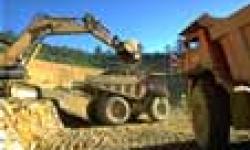The company conducts regular weekday tours of the mine site for visitors (bookings are essential). There is also a viewing platform with great views into the operating open pit. Enquire at the Waihi Information Centre for tours, displays and videos about mining, past and present.
Gold was first discovered on Pukewa (Martha Hill) in 1878 by prospectors John McCombie and Robert Lee. The samples of rock they had sent to be assayed were not considered worthwhile, so they left the area. Their claim was taken over by William Nicholl in 1879. He pegged out five acres, named the claim 'Martha' after a family member, and later a few small claims amalgamated to form the Martha Company. By 1882 the first battery was in operation. The Martha Mine became one of the most important gold and silver mines in the world. By 1952, when the mighty Martha Mine closed, around 5.6 million ounces (174,160kg) of gol5d and 38.4 million ounces (1,193,180kg) of silver had been produced from 11,932,000 tonnes of ore.
Seven vertical shafts had been sunk for the underground Martha Mine; the deepest was 600 metres from the surface. Radiating from the shafts was a network of 175 kilometres of tunnels on 15 horizontal levels. A workforce averaging 600 men was employed over the seventy year life span of the mine. In 1909, when gold production peaked, a total of 1500 people were employed in the mine and at the Victoria Battery.
Following the resurgence of the gold mining industry in New Zealand in the late 1970s the Martha Project was the first major hard rock mining operation to be commissioned. The Mine is situated in the township, and the Processing Plant, Waste Disposal Area, and Water Treatment Plant are located two kilometres away in a rural area. Because of its location, the mining operation has received a high level of public scrutiny. This is reflected by the stringent conditions set for the project.



Newmont Waihi Gold Education Centre reviews
Login to comment